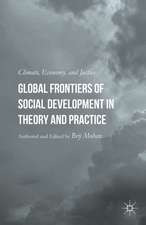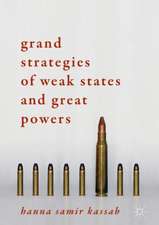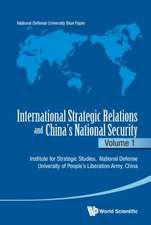Technology and the Intelligence Community: Challenges and Advances for the 21st Century: Advanced Sciences and Technologies for Security Applications
Editat de Margaret E. Kosalen Limba Engleză Hardback – 4 apr 2018
Technology and innovation have played an important role in determining the course of development of the intelligence community. Intelligence gathering for national security, however, is not limited only to the thread of technical capabilities but is a complex fabric of organizational structures, systemic undercurrents, and the role of personnel in key positions of decision making.
The book’s findings and conclusions encompass not just temporal variation but also cut across a diverse set of issue areas. This compilation is uniquely placed in the interdisciplinary space combining the lessons from key cases in the past to current developments and implementation of technology options.
| Toate formatele și edițiile | Preț | Express |
|---|---|---|
| Paperback (1) | 736.32 lei 38-44 zile | |
| Springer International Publishing – 26 ian 2019 | 736.32 lei 38-44 zile | |
| Hardback (1) | 747.51 lei 38-44 zile | |
| Springer International Publishing – 4 apr 2018 | 747.51 lei 38-44 zile |
Din seria Advanced Sciences and Technologies for Security Applications
- 20%
 Preț: 936.37 lei
Preț: 936.37 lei - 18%
 Preț: 738.20 lei
Preț: 738.20 lei - 18%
 Preț: 969.61 lei
Preț: 969.61 lei - 20%
 Preț: 934.69 lei
Preț: 934.69 lei - 20%
 Preț: 994.92 lei
Preț: 994.92 lei - 17%
 Preț: 491.11 lei
Preț: 491.11 lei - 18%
 Preț: 893.53 lei
Preț: 893.53 lei - 20%
 Preț: 991.60 lei
Preț: 991.60 lei - 20%
 Preț: 1051.84 lei
Preț: 1051.84 lei - 15%
 Preț: 704.36 lei
Preț: 704.36 lei - 15%
 Preț: 643.65 lei
Preț: 643.65 lei - 20%
 Preț: 1162.37 lei
Preț: 1162.37 lei - 18%
 Preț: 791.88 lei
Preț: 791.88 lei - 15%
 Preț: 649.22 lei
Preț: 649.22 lei - 20%
 Preț: 1273.74 lei
Preț: 1273.74 lei - 20%
 Preț: 889.12 lei
Preț: 889.12 lei - 15%
 Preț: 704.36 lei
Preț: 704.36 lei - 18%
 Preț: 903.93 lei
Preț: 903.93 lei - 15%
 Preț: 644.95 lei
Preț: 644.95 lei - 20%
 Preț: 689.45 lei
Preț: 689.45 lei - 5%
 Preț: 672.99 lei
Preț: 672.99 lei - 9%
 Preț: 732.28 lei
Preț: 732.28 lei - 18%
 Preț: 783.98 lei
Preț: 783.98 lei - 18%
 Preț: 1223.88 lei
Preț: 1223.88 lei - 20%
 Preț: 480.05 lei
Preț: 480.05 lei - 15%
 Preț: 648.42 lei
Preț: 648.42 lei - 18%
 Preț: 1224.36 lei
Preț: 1224.36 lei - 20%
 Preț: 1068.44 lei
Preț: 1068.44 lei - 18%
 Preț: 734.59 lei
Preț: 734.59 lei - 18%
 Preț: 1120.18 lei
Preț: 1120.18 lei -
 Preț: 381.43 lei
Preț: 381.43 lei - 24%
 Preț: 590.42 lei
Preț: 590.42 lei - 15%
 Preț: 586.38 lei
Preț: 586.38 lei - 20%
 Preț: 937.81 lei
Preț: 937.81 lei - 18%
 Preț: 1007.17 lei
Preț: 1007.17 lei - 24%
 Preț: 815.83 lei
Preț: 815.83 lei - 20%
 Preț: 937.81 lei
Preț: 937.81 lei - 18%
 Preț: 721.30 lei
Preț: 721.30 lei - 15%
 Preț: 646.75 lei
Preț: 646.75 lei - 15%
 Preț: 698.62 lei
Preț: 698.62 lei - 18%
 Preț: 794.07 lei
Preț: 794.07 lei - 18%
 Preț: 738.06 lei
Preț: 738.06 lei
Preț: 747.51 lei
Preț vechi: 983.57 lei
-24% Nou
Puncte Express: 1121
Preț estimativ în valută:
143.05€ • 155.33$ • 120.16£
143.05€ • 155.33$ • 120.16£
Carte tipărită la comandă
Livrare economică 18-24 aprilie
Preluare comenzi: 021 569.72.76
Specificații
ISBN-13: 9783319752310
ISBN-10: 3319752316
Pagini: 285
Ilustrații: IX, 287 p. 24 illus., 21 illus. in color.
Dimensiuni: 155 x 235 mm
Greutate: 0.64 kg
Ediția:1st ed. 2018
Editura: Springer International Publishing
Colecția Springer
Seria Advanced Sciences and Technologies for Security Applications
Locul publicării:Cham, Switzerland
ISBN-10: 3319752316
Pagini: 285
Ilustrații: IX, 287 p. 24 illus., 21 illus. in color.
Dimensiuni: 155 x 235 mm
Greutate: 0.64 kg
Ediția:1st ed. 2018
Editura: Springer International Publishing
Colecția Springer
Seria Advanced Sciences and Technologies for Security Applications
Locul publicării:Cham, Switzerland
Cuprins
Acknowledgements.- Introduction.- Interaction of Technology and Organization: Case Study of US Military COMINT in World War II.- Intelligence Innovation: Sputnik, the Soviet Threat, and Innovation in the US Intelligence Community.- Organizational Process, Leadership, and Technology for Intelligence Gathering: Development of Photo-Reconnaissance Satellites in the United States.- Exploring the Contributing Factors Associated with Intelligence Failures During the Cold War.- The Dragon Lady and the Beast of Kandahar: Bush and Obama-era US aerial drone surveillance policy based on a case study comparison of the 1960 U-2 crash with the 2011 RQ-170 crash. Wiretapping: The Interaction of Policy and Technology.- Nuclear Counterproliferation Intelligence.- Organizational Legitimacy and Open Source Intelligence.- Strategic Offensive Cyber Operations: Capabilities, Limitations, and Role of the Intelligence Community.- Promise and Perils of Big Data Science for Intelligence Community.- Situational Awareness in Megacities.- Augmenting Intelligence: What Augmented Reality Technology Means for the Intelligence Community.- Analyzing Public and State Reactions to Global Surveillance Disclosures: Using Ethical Frameworks to Gain Understanding.- Conclusions.
Notă biografică
Dr. Margaret E. Kosal is Associate Professor in the Sam Nunn School of International Affairs at Georgia Institute of Technology and Director of the Sam Nunn Security Program. During AY 2016-2017, she has been appointed Senior Adjunct Scholar to the Modern War Institute at West Point. Her research explores the relationships among technology, strategy, and governance. She focuses on two, often intersecting, areas: reducing the threat of weapons of mass destruction (WMD) and understanding the geopolitics of emerging technologies. She is the author of Nanotechnology for Chemical and Biological Defense, which explores scenarios, benefits, and potential proliferation threats of nanotechnology and other emerging sciences. Formally trained as an experimental scientist, Kosal earned a doctoral degree in Chemistry from the University of Illinois at Urbana-Champaign (UIUC) working on biomimetic and nano-structured functional materials. She is also the co-founder of a sensor company, where she led research on medical, biological, chemical, and explosive detection. Kosal previously has served as a Senior Advisor to the Chief of Staff of the U.S. Army, as Science and Technology Advisor within the Office of the Secretary of Defense (OSD), and as an Associate to the National Intelligence Council (NIC), in addition to other consulting. She has been recognized for her leadership across the U.S. federal government, specifically for efforts to coordinate across the DoD as part of the interagency Nonproliferation and Arms Control Technology Working Group, reporting to the National Security Council, and as member of the interagency federal group charged with leading the National Nanotechnology Initiative (NNI). Kosal was nominated to and led the US involvement in the NATO Nanotechnology for Defense Working Group. She is the recipient of multiple awards including the Office of the Secretary of Defense Award for Excellence. Recently, she was appointed the next Editor-in-Chief ofthe Cambridge University Press journal, Politics and the Life Sciences. She has lectured widely internationally, including invited briefs to the Organisation for the Prohibition Chemical Weapons (OPCW) in The Hague, the United Nations Interregional Crime and Justice Research Institute (UNICRI), and the United Nations Office for Disarmament Affairs (UNODA).
Textul de pe ultima copertă
This volume examines the role of technology in gathering, assimilating and utilizing intelligence information through the ages. Pushing the boundaries of existing works, the articles contained here take a broad view of the use and implementation of technology and intelligence procedures during the cold war era and the space race, the September 2011 attacks, and more recent cyber operations. It looks at the development of different technologies, procedural implications thereof, and the underlying legal and ethical implications. The findings are then used to explore the future trends in technology including cyber operations, big data, open source intelligence, smart cities, and augmented reality. Starting from the core aspects of technical capabilities the articles dig deeper, exploring the hard and soft infrastructure of intelligence gathering procedures and focusing on the human and bureaucratic procedures involved therein.
Technology and innovation have played an important role in determining the course of development of the intelligence community. Intelligence gathering for national security, however, is not limited only to the thread of technical capabilities but is a complex fabric of organizational structures, systemic undercurrents, and the role of personnel in key positions of decision making.
The book’s findings and conclusions encompass not just temporal variation but also cut across a diverse set of issue areas. This compilation is uniquely placed in the interdisciplinary space combining the lessons from key cases in the past to current developments and implementation of technology options.
Technology and innovation have played an important role in determining the course of development of the intelligence community. Intelligence gathering for national security, however, is not limited only to the thread of technical capabilities but is a complex fabric of organizational structures, systemic undercurrents, and the role of personnel in key positions of decision making.
The book’s findings and conclusions encompass not just temporal variation but also cut across a diverse set of issue areas. This compilation is uniquely placed in the interdisciplinary space combining the lessons from key cases in the past to current developments and implementation of technology options.
Caracteristici
Bridges history with past, current, and future technologies of strategic importance for intelligence and national security Connects historical lessons to modern developments in intelligence operations Makes a unique contribution by examining the organizational, ethical, and technical aspects and draws the linkages among these Recognizes the role of human intelligence and personnel involvement in strategic decision making across all chapters in this compilation Combines the analysis of technical capabilities with an in-depth analysis of soft and hard infrastructure in the field of intelligence
























